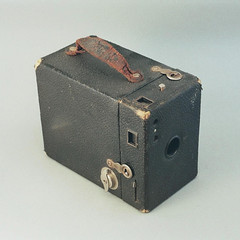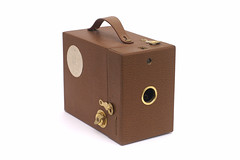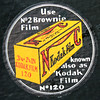Difference between revisions of "Hawk-eye No. 2"
m |
(Clarified confusion about "Verichrome" in earlier edit of this page) |
||
| Line 19: | Line 19: | ||
[http://www.flickr.com/photos/50678983@N00/168880906/in/pool-camerapedia http://static.flickr.com/63/168880906_bb2cf34093_t.jpg] | [http://www.flickr.com/photos/50678983@N00/168880906/in/pool-camerapedia http://static.flickr.com/63/168880906_bb2cf34093_t.jpg] | ||
</div> | </div> | ||
| − | The Hawk-eye No. 2 has two viewfinders. Both are prism finders, one seen from above and the other from the right side of the camera. There is a simple [[meniscus lens]]. An ad placed inside the camera advises you to insist on Kodak [[120 film]], either regular or Verichrome< | + | The Hawk-eye No. 2 has two viewfinders. Both are prism finders, one seen from above and the other from the right side of the camera. There is a simple [[meniscus lens]]. An ad placed inside the camera advises you to insist on Kodak [[120 film]], either regular or Verichrome. (The latter was not a color film; it was an improved B&W emulsion introduced by Kodak in 1931<ref>[http://www.kodak.com/global/en/corp/historyOfKodak/1930.jhtml History of Kodak: 1930–1959] at the [http://www.kodak.com/global/en/corp/historyOfKodak/historyIntro.jhtml Kodak corporate history site].</ref>, with better sensitivity to green and yellow light.) |
<div style="clear:both;"> | <div style="clear:both;"> | ||
| Line 40: | Line 40: | ||
== Simpler versions: original Model C and 50th anniversary camera == | == Simpler versions: original Model C and 50th anniversary camera == | ||
<div class="floatleft">[http://www.flickr.com/photos/awcam/4085568719/in/pool-camerapedia http://farm3.static.flickr.com/2477/4085568719_b72c68bb11_t.jpg]</div>The Hawk-Eye No. 2 model C of 1913 was a simpler model with just one viewfinder, and no choice of aperture. The camera was reissued in 1930 as anniversary giveaway of Eastman Kodak Co. for 550,000 children at the age of 12. | <div class="floatleft">[http://www.flickr.com/photos/awcam/4085568719/in/pool-camerapedia http://farm3.static.flickr.com/2477/4085568719_b72c68bb11_t.jpg]</div>The Hawk-Eye No. 2 model C of 1913 was a simpler model with just one viewfinder, and no choice of aperture. The camera was reissued in 1930 as anniversary giveaway of Eastman Kodak Co. for 550,000 children at the age of 12. | ||
| + | {{br}} | ||
| + | ==Notes== | ||
| + | <references/> | ||
== Links == | == Links == | ||
Revision as of 13:48, 19 April 2011
Contents
Origins
The original Hawk-eye cameras were made by the Boston Camera Co., which was taken over by Blair Camera Co. in 1890, in turn taken over by Eastman Kodak in 1899. This is the reason why there's no Hawk-eye No. 1 in the Kodak list: that camera, a 4×5 inch plate camera, was made by the original company. source: McKeown
Cardboard and leatherette
It probably wasn't a very expensive camera. The Hawk-eye No. 2 has a cardboard body (on the example in the photograph, the cardboard is showing on the edges). The body is covered with black leatherette and it has a real leather strap on top. They were made from 1913 onwards and this particular one was produced in Great Britain (see leatherette imprint). It uses 120 film to make 6×9 cm pictures. Since it was made in Britain, 2 ¼ × 3 ¼ inch is probably a better way of describing the format.
Viewfinder and lens
The Hawk-eye No. 2 has two viewfinders. Both are prism finders, one seen from above and the other from the right side of the camera. There is a simple meniscus lens. An ad placed inside the camera advises you to insist on Kodak 120 film, either regular or Verichrome. (The latter was not a color film; it was an improved B&W emulsion introduced by Kodak in 1931[1], with better sensitivity to green and yellow light.)
Transport and opening the camera
Film is wound with this double lever, turned in the direction of the arrow. Frames are counted via a red window in the back. Opening the camera is less obvious. Even after opening the eye-locks, the two parts stay firmly together. Only after pulling out the double winding lever will they come apart.
Shutter and aperture
The shutter is of the simple "guillotine" type. It has just one speed, which sounds like 1/30s. Two apertures are available through a pull-out strap on the top of the box. This will put openings of different diameters in the pathway of the light.
Simpler versions: original Model C and 50th anniversary camera
The Hawk-Eye No. 2 model C of 1913 was a simpler model with just one viewfinder, and no choice of aperture. The camera was reissued in 1930 as anniversary giveaway of Eastman Kodak Co. for 550,000 children at the age of 12.
Notes
Links
- a large collection of Kodak Box cameras on OZcamera
- Various models of Hawk-Eye No.2 at Sylvain Halgand's www.collection-appareils.fr :







